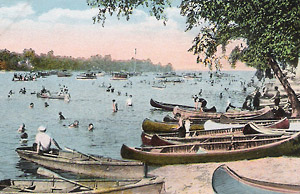Burlington, NJ | View Map

Bathing and Boating, Burlington Island. Early twentieth century postcard. Credit: Collection of Herman Costello
Burlington Island lies directly opposite the city of Burlington and the histories of the two places have been intertwined for centuries. The island is identified as Mattinecunck Island on early maps and is the site of one of New Jersey’s first European settlements. The 300-acre island has changed ownership many times and has been used for agriculture, recreation, and commerce for nearly four hundred years. Beginning in the 1620s, the Dutch West India Company and later Swedes used the island as a trading post and for farming. After 1664, when the area came under English control, the island was used as a frontier trading and military outpost.
Burlington City was given title to the island in 1682. The Assembly of West Jersey stipulated that all rents and profits from the island be used “…for the encouragement of learning and the better education of youth.” This is the first public education trust fund in New Jersey and is one of the oldest in the nation. A board of managers for the fund was organized in 1727. Over the centuries, the trust has been funded with proceeds from land sales, and rents from farming, fishing, and mining. In 1767, a century before free public education was mandated in New Jersey, money from the trust provided funds for tuition and later, construction of school buildings. In 1824, the New Jersey Legislature officially incorporated the managers of the Island School Trust fund. In 1853, with the approval of the Legislature, the board sold the downstream portion of the island. It remained under private ownership until 1953.

Island Beach Amusement Park Roller Coaster. Credit: Collection of Herman Costello
From 1900 to 1917, the lower part of the island was a popular picnic ground and bathing area. In 1917 Island Beach Amusement Park was constructed and became a regional attraction. Fires destroyed the amusement park in the 1920s and 1930s, and the southern part of the island was sold to a series of private owners whose ambitious development plans failed to materialize. In the early twentieth century, wells on the island were tapped to provide fresh water when the Delaware became too polluted for use.
Under an agreement signed in 1953, title to the island returned to the city in exchange for gravel and sand mining rights. The mining created a 100-acre lagoon on the site of the first Dutch settlement and fill from river dredging was added to the upper and lower sections of the island. Today, the island is uninhabited.
For more information:
Banner art: Island Beach Amusement Park Roller Coaster. Credit: Collection of Herman Costello






